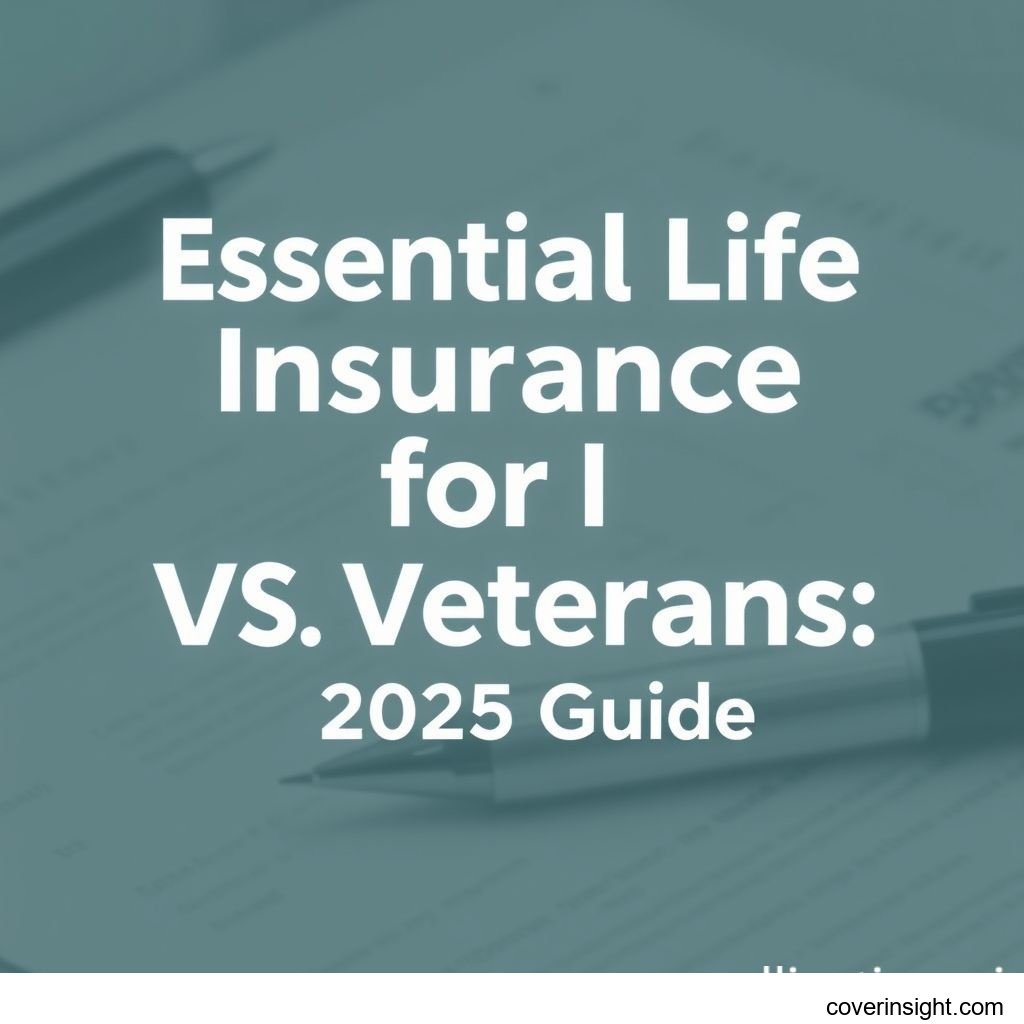Introduction
For millions of service members transitioning to civilian life, securing comprehensive financial protection is a top priority. Among the essential considerations for long-term security, veterans group life insurance stands out as a vital benefit designed to offer peace of mind. As we look towards 2025, understanding the nuances of this coverage remains crucial for US veterans and their families. This guide aims to demystify the options available, from basic coverage details to cost analysis and enrollment processes, ensuring you can make informed decisions about your financial future.
This specialized form of life insurance policy is specifically tailored to meet the unique needs of those who have served, providing an accessible pathway to securing a financial safety net for beneficiaries. It's an important component of the overall support structure available to veterans, offering competitive rates and flexible terms often not found in the private market.
Coverage Details
Understanding what your veterans group life insurance covers, and what it doesn't, is paramount to utilizing this benefit effectively. This section delves into the specifics of typical inclusions and common exclusions you should be aware of.
What’s Included
A standard veterans group life insurance policy is designed to provide financial relief to your designated beneficiaries upon your passing. Key components typically include:
-
Tax-Free Benefit: Generally, the death benefit paid to beneficiaries is tax-free, maximizing the financial support they receive.
-
Flexible Payout Options: Beneficiaries often have the choice of receiving a lump sum payment or a series of monthly installments, offering flexibility to meet their financial planning needs.
-
Guaranteed Coverage: Once enrolled and premiums are paid, coverage is typically guaranteed, regardless of future health changes, as long as eligibility criteria continue to be met.
-
Coverage Amounts: Veterans can typically choose coverage amounts in increments, often up to a maximum set by the Department of Veterans Affairs (VA), which usually aligns with the amount of Service-Disabled Veterans' Life Insurance (SGLI) they had while serving.
-
Accelerated Benefits: In some cases, if the insured is diagnosed with a terminal illness with a limited life expectancy, a portion of the death benefit may be paid out early.
This comprehensive coverage aims to provide a robust financial safety net, helping to cover immediate expenses, ongoing living costs, and future financial goals for surviving family members.
Common Exclusions
While robust, veterans group life insurance policies do come with certain exclusions, similar to many private life insurance policy offerings. Being aware of these can prevent unexpected issues for your beneficiaries:
-
Suicide Clause: Most policies include a clause stating that if the insured commits suicide within a specific period (typically one or two years from the policy's effective date), the death benefit may not be paid, or only premiums paid will be returned.
-
Misrepresentation: If the veteran provides false or misleading information during the application process, the VA may have grounds to deny a claim.
-
Illegal Activities: Death resulting directly from the veteran's engagement in illegal activities may be excluded.
-
War/Hostilities Clause (Rare for VGLI): While less common for VGLI compared to some private plans, some policies might have specific exclusions related to death occurring during active participation in war or hostile actions, though VGLI is specifically for veterans. Always review the specific policy terms.
It's always recommended to review the detailed policy document provided by the VA to understand all terms and conditions specific to your veterans group life insurance plan.
Cost Analysis
The cost of veterans group life insurance is often one of its most attractive features, providing affordable coverage. However, premiums can vary based on several factors. Understanding these elements can help you manage your budget and maximize your benefits.
Price Factors
Several elements influence the monthly premiums for your veterans group life insurance:
-
Age: This is the most significant factor. Premiums typically increase with the insured's age, reflecting a higher actuarial risk. Younger veterans will generally secure much lower rates.
-
Coverage Amount: The higher the death benefit you choose, the higher your monthly premium will be. Options usually range from tens of thousands to hundreds of thousands of dollars.
-
Health (Initial Enrollment): While VGLI is guaranteed renewable, the initial transition from SGLI requires enrollment within a specific timeframe to avoid medical underwriting. If you enroll outside this window, you might need to prove good health, which could impact rates or eligibility for some private term life insurance options if you explore those later.
-
Tobacco Use: While less explicitly a direct factor for VGLI's standard rate tables (which are largely age-based), it's a critical factor for private market alternatives.
The VA's rate tables for veterans group life insurance are publicly available, allowing veterans to easily calculate potential costs based on their age and desired coverage level. These rates are often highly competitive when compared to private life insurance policy options, especially for those with pre-existing conditions.
Saving Tips
Managing the cost of your veterans group life insurance while ensuring adequate coverage is achievable with a few strategies:
-
Enroll Early: The best way to save on VGLI is to convert your SGLI to VGLI as soon as possible after separating from service. Your rates will be based on your age at enrollment, locking in lower premiums for longer.
-
Choose the Right Coverage Level: Assess your family's actual financial needs. Don't over-insure, but ensure you have enough to cover debts, future education, and ongoing living expenses. A careful analysis of your liabilities and future plans can guide this decision.
-
Review Periodically: As your life circumstances change (e.g., children grow up, debts are paid off, assets accumulate), your insurance needs may evolve. Review your policy every few years to ensure your coverage amount still aligns with your requirements.
-
Compare with Private Market (Carefully): While VGLI is often a great deal, especially as you age or if your health declines, it's wise to occasionally compare its rates with private term life insurance offerings. Younger, very healthy veterans might find competitive life insurance policy rates elsewhere, but VGLI's guaranteed renewability is a strong advantage.
For broader financial planning and insurance resources, you can explore guides on Insurance Resources Global. Understanding your options and making informed choices is key to maximizing the value of your coverage.
Eligibility and Enrollment
Accessing veterans group life insurance requires meeting specific eligibility criteria and following the correct enrollment procedures. This section outlines who qualifies and the steps to take to secure your coverage.
Who Qualifies?
Eligibility for veterans group life insurance (VGLI) primarily depends on your prior military service and your separation from service:
-
Automatic Eligibility for SGLI Holders: Most service members who separate or retire from active duty, National Guard, or Reserve duty and were covered by Servicemembers' Group Life Insurance (SGLI) are eligible to convert their SGLI to VGLI.
-
Application Window: You must apply for VGLI within one year and 120 days of your separation from service.
-
If you apply within 240 days of separation, you do not need to provide proof of good health.
-
If you apply after 240 days but within the one-year and 120-day window, you will need to provide proof of good health (e.g., a medical exam).
-
-
Covered Circumstances: Eligibility also extends to service members who were covered by SGLI and were separated under specific circumstances, such as:
-
Being released from active duty or full-time National Guard duty.
-
Being assigned to the Ready Reserve or Standby Reserve.
-
Continuing in the National Guard or Reserves.
-
Understanding these timeframes is critical to ensuring seamless transition of your coverage without requiring a health screening.
How to Apply
Applying for veterans group life insurance is a straightforward process, primarily managed online or via mail:
-
Determine Your Eligibility: Confirm that you meet the criteria outlined above, especially regarding the application timeframe since separation.
-
Gather Required Documents: You'll need your DD214 (Certificate of Release or Discharge from Active Duty) or other official documentation proving your service and separation.
-
Choose Your Coverage Amount: Decide how much coverage you need, up to the maximum amount of SGLI you held at separation.
-
Submit Your Application:
-
Online: The quickest and most recommended method is to apply through the VA's eBenefits portal.
-
Mail: You can also download and complete VA Form SGLV 8716, "Application for Veterans' Group Life Insurance," and mail it to the address provided on the form.
-
-
Designate Beneficiaries: Clearly name your beneficiaries and specify their share of the death benefit. It's advisable to name primary and secondary beneficiaries.
-
Begin Premium Payments: Once your application is approved, you'll need to start paying your monthly premiums to keep your coverage active.
For more information on navigating VA benefits, general US insurance information can be found on US Insurance Home. Ensuring your application is complete and submitted on time is essential to secure this valuable benefit.
Benefits of VA Life Insurance
Veterans group life insurance provides a unique set of advantages specifically designed for service members and their families. These benefits extend beyond just financial payout, offering critical support and ease of access.
Financial Security
The primary goal of any life insurance policy is to provide financial security, and VGLI excels in this regard for veterans:
-
Debt Repayment: The payout can cover outstanding mortgages, car loans, credit card debts, and other financial obligations, preventing your family from inheriting burdens.
-
Income Replacement: For families relying on your income, the death benefit can serve as a vital replacement, allowing them to maintain their standard of living for a period.
-
Education Funding: It can fund future education expenses for children or grandchildren, ensuring their academic aspirations aren't derailed by unforeseen circumstances.
-
Funeral and Burial Costs: These immediate expenses can be substantial, and the insurance payout provides immediate funds to cover them without putting financial strain on grieving loved ones.
-
Legacy Planning: It allows you to leave a financial legacy, supporting long-term goals or charitable contributions.
This comprehensive financial safety net ensures that your loved ones are protected from financial hardship during an incredibly difficult time.
Ease of Access
Beyond the financial benefits, the accessibility and veteran-centric design of veterans group life insurance are significant advantages:
-
Guaranteed Renewability: Once enrolled, VGLI is guaranteed renewable for life, meaning your coverage cannot be canceled as long as premiums are paid, regardless of changes in health. This is a crucial distinction from many private term life insurance policies.
-
No Medical Exam (If Timely): As mentioned, applying within 240 days of separation means no medical examination is required, making enrollment simple and accessible even for those with pre-existing conditions.
-
Affordable Premiums: The government-subsidized nature of the program often translates to lower premiums compared to what many veterans might find in the private market, especially as they age or if their health is not perfect.
-
Automatic Coverage Conversion: The seamless conversion from SGLI minimizes gaps in coverage during the transition from military to civilian life.
-
Trusted Source: Dealing with the Department of Veterans Affairs (VA) provides a level of trust and stability that can be reassuring for many veterans.
These factors make veterans group life insurance a highly convenient and dependable option for ensuring your family's financial future.
Comparing Options
While veterans group life insurance is an excellent option, it's always wise to understand how it stacks up against other available insurance products. This comparison will help you determine the best fit for your specific needs, whether it's solely VGLI or a combination of policies.
VA vs. Private Providers
When considering life insurance policy options, veterans essentially have two main avenues: the VA's offerings and the private insurance market.
| Feature | Veterans Group Life Insurance (VGLI) | Private Market Life Insurance (e.g., Term Life) | | :-------------------- | :----------------------------------------------------------------- | :------------------------------------------------------------------ | | Eligibility | Requires prior SGLI, application within specific timeframe. | Open to general public, subject to underwriting. |
| Medical Exam | Not required if applied for within 240 days of separation. | Often required, can impact rates/eligibility. |
| Guaranteed Renewability | Yes, for life, regardless of health. | Term policies typically expire after a set period; renewal often requires re-qualification or higher rates. |
| Premium Structure | Age-based, fixed for 5-year periods, increases with age. | Can be fixed for the entire term (e.g., 20 years), then increases. |
| Affordability | Often highly competitive, especially for older or less healthy vets. | Can be more competitive for young, very healthy individuals on a pure term basis. |
| Policy Types | Primarily term life insurance (group coverage). | Offers various types: term, whole, universal, etc. |
| Coverage Max | Limited to maximum SGLI held at separation (e.g., $500,000 as of 2025). | Varies widely by provider, can be much higher. |
For many veterans, VGLI serves as a strong foundation due to its guaranteed nature and competitive rates, particularly if they anticipate health issues or want lifelong coverage without medical exams. However, for those seeking higher coverage amounts or specific policy types not offered by VGLI, the private market is essential.
Choosing the Right Life Insurance Policy
Selecting the optimal life insurance policy involves a thorough assessment of your financial situation, family needs, and future goals. Here are key considerations:
-
Assess Your Needs: Calculate how much coverage your family would genuinely require to cover immediate expenses, ongoing living costs, and future financial goals (e.g., college, retirement savings). A common rule of thumb is 5-10 times your annual income.
-
Consider Your Health and Age: If you're young and in excellent health, you might find competitive rates for term life insurance in the private market. If you have pre-existing conditions or are older, VGLI's guaranteed coverage is often superior.
-
Term vs. Whole Life:
-
Term Life Insurance: Provides coverage for a specific period (e.g., 10, 20, 30 years) and is generally more affordable. It's suitable for covering specific liabilities like a mortgage or until children are grown. VGLI functions as a type of term coverage.
-
Whole Life Insurance: Offers lifelong coverage and builds cash value, but is significantly more expensive.
-
-
Future Needs: Think about how your needs might change. Do you plan to have more children? Will your income increase substantially? These factors can influence the type and amount of coverage you need.
-
Budget: Determine how much you can comfortably afford for monthly premiums without compromising other financial priorities.
Consulting with a financial advisor can also provide personalized guidance. Resources like the National Association of Insurance Commissioners and your State Insurance Departments can offer valuable insights into consumer protections and local regulations regarding a life insurance policy. Ultimately, the best strategy for many veterans is to leverage the robust and affordable base provided by veterans group life insurance and then supplement it with private coverage if additional needs arise.
FAQs
Here are some frequently asked questions about veterans group life insurance to help clarify common concerns.
How much does veterans group life insurance cost?
The cost of veterans group life insurance depends primarily on your age and the amount of coverage you choose. Premiums increase as you age, typically in 5-year increments. For example, a 30-year-old might pay significantly less per month for $400,000 in coverage than a 50-year-old. The VA provides detailed rate tables online for easy calculation.
What affects premiums?
As mentioned, your age is the dominant factor for veterans group life insurance premiums. The amount of coverage you select also directly impacts the premium. While your health doesn't affect premium rates if you apply within 240 days of separation, it can affect your eligibility or rates if you miss this window and need to undergo health screening, or if you consider private term life insurance alternatives.
Is it mandatory?
No, veterans group life insurance is not mandatory. It is an optional benefit offered to eligible service members who previously held SGLI. While not required, it is highly recommended for veterans who wish to secure financial protection for their families after leaving service.
How to choose?
Choosing the right veterans group life insurance amount involves assessing your family's financial needs. Consider your outstanding debts (mortgage, loans), income replacement needs for your family, future educational expenses for dependents, and funeral costs. A common method is to multiply your annual income by 5-10 years, then add any significant liabilities. Compare this figure with the maximum coverage offered by VGLI and other private life insurance policy options.
Consequences of no coverage?
Opting for no life insurance coverage, or insufficient coverage, can have severe financial consequences for your loved ones upon your passing. Without a death benefit, your family may struggle to cover:
-
Funeral and burial expenses, which can be thousands of dollars.
-
Outstanding debts, potentially forcing the sale of assets like a home.
-
Loss of your income, impacting their ability to pay for daily living expenses, education, or retirement savings.
Adequate coverage from veterans group life insurance or a private life insurance policy ensures your family is not left with a significant financial burden during a time of grief.








Comments